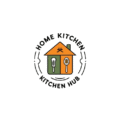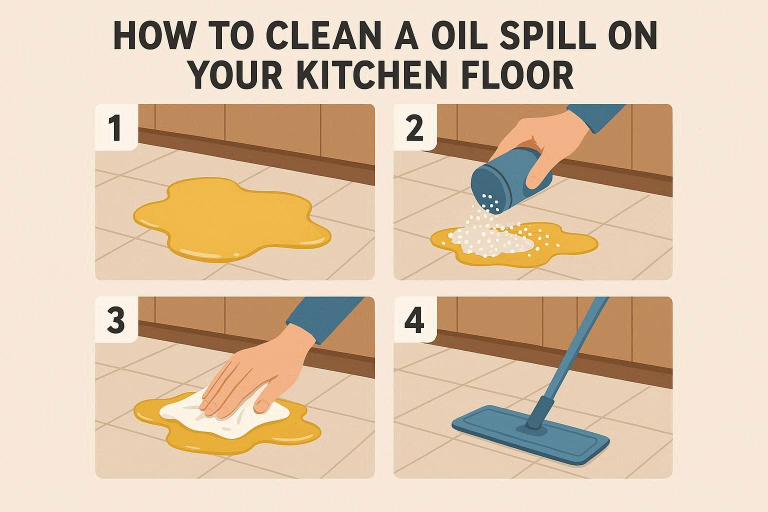We’ve all been there: you’re cooking up a storm in the kitchen, and suddenly, a bottle of cooking oil tips over, spilling across the floor. It’s frustrating, right? Not only does it leave a mess, but it also creates a slippery surface that could lead to accidents or falls. Not to mention, if left unattended, the oil can stain your floor, leaving behind unsightly marks. That’s why it’s crucial to clean up oil spills in your kitchen quickly and effectively.
In this post, we’ll dive into practical tips and methods to help you clean up those spills with ease. Whether you’re dealing with a small splatter or a large puddle, we’ve got you covered with simple solutions that will keep your kitchen looking fresh and your floors safe.
How to Clean Oil Spills on the Kitchen Floor
Oil spills can be a real headache, but cleaning them up doesn’t have to be. Here’s a step-by-step guide to help you tackle those Cleaning Guide for Home & Kitchen spills efficiently:
Act Fast: Why Cleaning Immediately Helps Prevent Staining or Slick Spots
The key to a successful cleanup is acting quickly. Oil can seep into certain floor types and cause stains if left untreated for too long. Plus, when the oil sits too long, it becomes even harder to clean up. By cleaning up right away, you can prevent greasy residue from setting in and causing damage to your floor.
Gather Necessary Tools
Before you begin, gather the right tools. Here’s what you’ll need:
- Paper towels or cloth towels: These will help you absorb the oil and mop up the excess.
- Dish soap: Dish soap is specifically designed to break down grease, making it ideal for oil spills.
- Baking soda or cornstarch: These absorbent materials can help soak up excess oil, especially if the spill is large.
- A mop and bucket with warm water: These will be used to wipe the floor clean.
Use Dish Soap and Warm Water to Break Down the Oil
Start by soaking up as much oil as you can with paper towels or a cloth towel. Once the bulk of the oil is gone, it’s time to break down the remaining residue. Mix a generous amount of dish soap with warm water and apply it to the stained area. Dish soap is a powerful degreaser that will break down the oils and make it easier to clean.
Gently scrub the area using a soft cloth or sponge. Make sure to cover the entire spill, as the oil might have spread further than you realize.
Wipe the Area Thoroughly with a Cloth
After scrubbing, use a clean cloth to wipe away the soapy water and oil mixture. This will help remove any leftover oil and soap residue from the floor. Be sure to keep rinsing your cloth regularly to ensure you’re wiping up as much oil as possible.
Rinse and Repeat if Necessary
If the oil stain persists, don’t worry. Simply repeat the process. Apply more dish soap and warm water, scrub the area again, and wipe it clean. It may take a couple of rounds to remove the oil from the floor completely, but persistence will pay off.
How to Get Rid of Oily Kitchen Floors
Cleaning up a spill is one thing, but what about preventing oily buildup on your kitchen floor in the future? Here are some tips to help keep your kitchen floor free from grease and grime:
Regular Mopping with Degreasing Solutions
To maintain a clean kitchen floor, make it a habit to mop regularly. Use a degreasing solution specifically designed for floors. These solutions are formulated to cut through grease and oils, keeping your floor sparkling clean.
You can even make your own degreasing solution at home by mixing dish soap with warm water. A little vinegar added to the mix can help remove stubborn oil stains as well.
Using a Mop with Soap and Vinegar Mixture for Oily Floors
For an added layer of cleaning, mix vinegar with warm water and a bit of dish soap. This solution works wonders on oily kitchen floors. Vinegar’s acidity helps break down grease, while the soap lifts and loosens the oil from the floor’s surface. Mop the floor with this mixture to maintain a grease-free environment.
Deep Cleaning Methods for Stubborn Oil Stains
If your kitchen floor is covered in stubborn oil stains that won’t come out with regular cleaning, it might be time for a deeper clean. Use a floor cleaner that’s designed for tough grease stains. These cleaners usually contain stronger chemicals that can penetrate deep into the surface and remove even the most persistent oil stains.
Use of Commercial Floor Degreasers and How They Work
If your oil problems are particularly persistent, consider using a commercial floor degreaser. These products are specifically designed to handle heavy-duty oil and grease spills. Apply the degreaser to the affected area and follow the instructions on the label. They often require you to let the solution sit for a while before scrubbing, so be sure to follow the recommended time frame for the best results.
What Is the Best Thing to Soak Up Spilled Oil?
Sometimes, the best way to clean up a spill is by soaking up the excess oil before cleaning the area with soap and water. Here are some of the best materials to soak up spilled oil:
Paper Towels vs. Cloth Towels for Quick Absorption
If the oil spill is small, paper towels are a great option. They absorb oil quickly and can be disposed of after use. If you’re dealing with a larger spill, cloth towels work better since they can be washed and reused. However, make sure to use towels that you don’t mind getting oily.
Baking Soda and Cornstarch: Absorbent Materials for Large Spills
For bigger spills, both baking soda and cornstarch are excellent absorbents. Sprinkle a generous amount over the oil spill, and let it sit for a few minutes. These powders will soak up the oil and make it easier to wipe away. After the oil has been absorbed, sweep or vacuum up the powder and follow up with the soap and water cleanup method.
Why Cat Litter Is a Great Option for Large Amounts of Oil
Cat litter might sound like an odd solution, but it’s actually one of the best ways to soak up large amounts of oil. The granules are highly absorbent, so they can quickly soak up the oil. After letting the litter sit on the spill for a few minutes, scoop it up, and clean the floor with soap and water.
Using Sawdust or Other Absorbent Materials for Heavy-Duty Cleanup
In extreme cases, where the oil spill is significant, sawdust or other absorbent materials can be used to soak up large quantities of oil. Simply pour the material over the spill and let it absorb the oil before sweeping it up.
Does Vinegar Remove Oil from the Floor?
Many people wonder if vinegar can help clean up oil spills. The answer is yes! Vinegar is a versatile cleaner, and its acidity helps break down grease and oils. Here’s how to use it effectively:
How Vinegar Works as an Oil Remover
Vinegar’s acidic nature makes it a natural degreaser. It helps break down the bonds between the oil and the floor, making it easier to wipe away. This is why it’s often used in combination with other cleaning solutions, like dish soap, to tackle stubborn grease stains.
How to Use Vinegar to Clean the Kitchen Floor After an Oil Spill
Mix equal parts of vinegar and water in a mop bucket. Add a few drops of dish soap if you want to boost its grease-cutting power. Mop the area with this solution, ensuring that it covers the entire spill. You’ll find that vinegar helps lift and dissolve the oil, making it easier to clean.
Mixing Vinegar with Other Ingredients Like Baking Soda for Better Results
For tougher stains, consider mixing vinegar with baking soda. The combination of vinegar’s acidity and baking soda’s abrasiveness works wonders on stubborn oil stains. Simply sprinkle baking soda over the spill, add vinegar on top, and let it fizz for a few minutes. Then, scrub and wipe away the mess.
Pros and Cons of Using Vinegar on Different Types of Flooring
While vinegar is a great natural cleaner, it’s not ideal for every floor type. It’s safe for tile, vinyl, and some hardwood floors, but it can damage sensitive floors like marble and granite. Always test a small, inconspicuous area before using vinegar on your entire floor.
Conclusion
Dealing with an oil spill on your kitchen floor doesn’t have to be a nightmare. With the right tools and techniques, you can quickly clean up the mess, prevent future buildup, and keep your kitchen safe. Whether you’re using dish soap and warm water, absorbing materials like baking soda, or turning to vinegar for extra cleaning power, you’ll have your floor sparkling in no time.
Remember to act fast when a spill happens, use the right materials for cleanup, and keep your kitchen floor regularly maintained with degreasing solutions. This will not only help keep your floors clean but also ensure the safety of everyone who walks through your kitchen.
FAQs
How to Clean an Oil Spill on a Kitchen Floor?
To clean an oil spill on your kitchen floor, start by absorbing as much oil as possible using paper towels or cloth towels. Then, use a mixture of dish soap and warm water to scrub the affected area. Wipe with a clean cloth, and repeat if necessary until the oil is gone.
How to Clean Up Spilled Oil on Kitchen Floor?
For spilled oil on the kitchen floor, quickly absorb the excess oil with towels. After that, use dish soap mixed with warm water to break down the oil. Scrub gently, rinse the area, and repeat if the stain persists.
How to Clean Up an Oil Spill in the Kitchen?
An oil spill in the kitchen can be cleaned up by acting fast. First, soak up the excess oil with absorbent materials like paper towels or cornstarch. Then, apply a soap and warm water solution to the spill, scrub gently, and wipe clean with a cloth.
How to Get Rid of Oily Kitchen Floor?
To get rid of an oily kitchen floor, mop regularly with a degreasing solution, such as dish soap mixed with warm water. For stubborn oil stains, use a mixture of vinegar and water, or commercial degreasers, to keep your floor grease-free and spotless.
Call to Action
Have you ever had to deal with a big oil spill in the kitchen? Share your tips and experiences with us in the comments! If you found these cleaning methods helpful, don’t forget to subscribe for more home cleaning tips and tricks.

